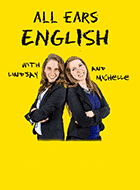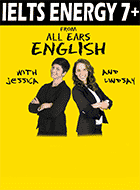Have you encountered any pesky English prepositions lately?
Knowing which preposition to use can be the most difficult aspect of English grammar.
Today you’ll get a secret hack on whether to use ‘in’ or ‘on’ when it comes to transportation.
Plus, get full clarity on the prepositions ‘in’, ‘on’, and ‘at’ for a place.
This will give you the tools to use prepositions of place with confidence!
Pesky prepositions
This episode starts by discussing the idiom ‘a lot on your plate.’
This is great to use when you want to ask if someone has a lot going on.
- a lot on your plate: busy
Imagine they have a plate that is full of food.
Today’s episode is inspired by a new listener of All Ears English.
“I originally came from the Philippines. I’ve been in the US for more than 15 years but I’m still having an issue with when to use ‘on’, ‘in’, ‘at’, ‘into’, and ‘unto.’ Please give examples. Thank you so much. Looking forward to listening to your podcast.”
Arlene
This is a question that often comes up for many English learners.
Like Arlene, this is even a struggle for those who have lived in English-speaking countries for many years.
It is hard to be completely fluent with the confusion caused by these prepositions.
Prepositions of place
Many prepositions are used for both place and time.
In a recent episode, Lindsay and Aubrey shared how to use ‘in,’ ‘on’ and ‘at’ for time.
You can see that episode here.
There are also guidelines for how to use these when talking about place and location.
Lindsay and Aubrey discuss each preposition and share with you how to use them.
#1: At
The preposition ‘at’ is often used to refer to places or locations when referring to a specific point.
You can use this to talk about the exact location of a person or object.
A lot of people get this confused and use ‘to’ instead of ‘at’ when referring to a place.
This will sound unnatural and happens when you are directly translating from your native language to English.
Examples:
His chair is at his desk.
I’m waiting at the hotel entrance.
I’m at the gym.
#2: In
The preposition ‘in’ is used to refer to something in an enclosed and defined space.
It doesn’t have to be totally enclosed.
A space can be considered enclosed even if it doesn’t have a roof.
For example, we say we’re ‘in’ a swimming pool.
Example:
The ball is in the pool.
This is also used for cities, countries, or other large areas.
Example:
I am in the U.S.
It also is used for a metaphorical place that is inside something else.
Example:
I have so much love in my heart.
#3: On
This is used to refer to something that is touching the surface of something else but not in an enclosed space.
Examples:
The ball is on the grass.
The pen is on the desk.
The kids are on the sidewalk.
Bonus preposition tip
English students often raise the question of ‘in’ and ‘on’ when talking about different modes of transportation.
In English, we say we’re ‘in a car’ but ‘on a bus’ and ‘on a train.’
It can be confusing for language learners to know which to use or the reasoning for it.
A quick tip is to consider whether you can stand in the vehicle.
Since you cannot stand in a car, truck or van, we use ‘in.’
In a plane, bus or train, you are able to stand, so use the preposition ‘on.’
Is it a people mover?
Another way to determine which preposition to use is to think about vehicles as ‘people movers.’
If a vehicle is meant to transport large amounts of people we say we’re ‘on’ it because we’re on board.
Examples
I’m on a cruise ship.
She’s on the bus.
They’re on a train.
Roleplay
The following roleplay highlights the prepositions shared in today’s episode.
This will provide an idea of how these are used in a conversation.
In this scenario, Lindsay and Aubrey are making plans to meet for a coffee.
Lindsay: When are you free? What’s on your schedule for today?
Aubrey: I can go at 10. Should we try a new coffee shop?
Lindsay: Yes, let’s meet at Mean Bean. I’m at my house now, in my office. But I could be there by 10.
Aubrey: Awesome! I’ll meet you at the subway entrance and we can ride together.
A glaring mistake
Prepositions are everywhere.
They’re used in nearly every sentence!
Errors with prepositions are glaring to a native English speaker.
This is because native speakers don’t make these errors so they stand out.
Notice prepositions as you read and listen to English.
Don’t stress about these mistakes, as the most important goal is connection!
Takeaway
It’s extremely helpful to be aware of the common mistakes with prepositions.
It will propel you to a higher level of English once you nail down using prepositions correctly.
Don’t get overwhelmed with needing to be perfect with your English grammar.
As long as you are making that connection, don’t break the opportunity to build a relationship.
What’s important is you get to complete your thought and the person you’re talking to understands your point.
Keep practicing and immersing yourself in English materials and you’ll get the hang of speaking like a native English speaker.
What other prepositions do you find confusing?
We’d love to hear from you in the comments.








